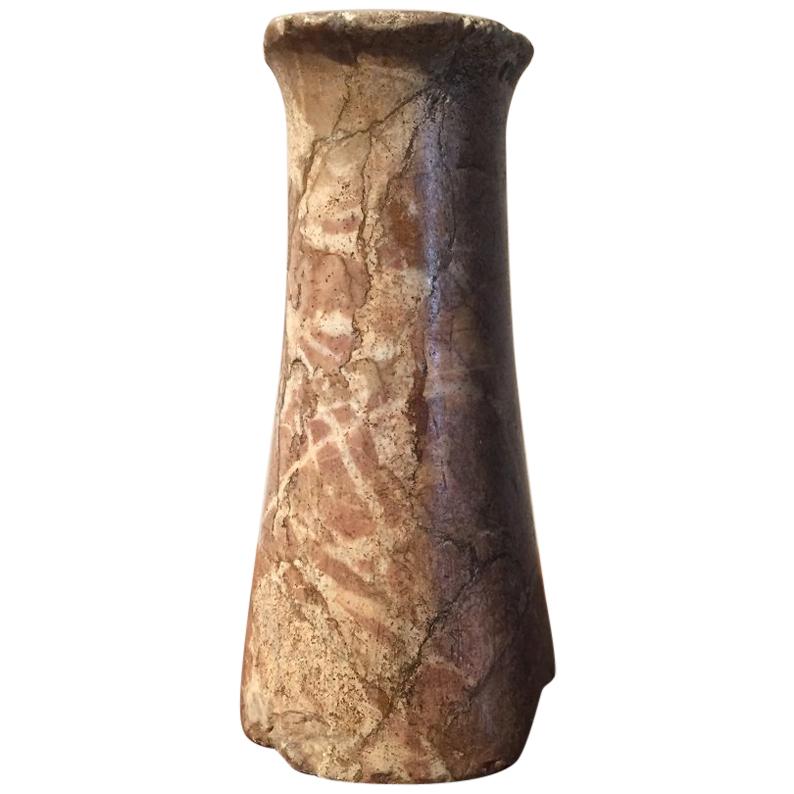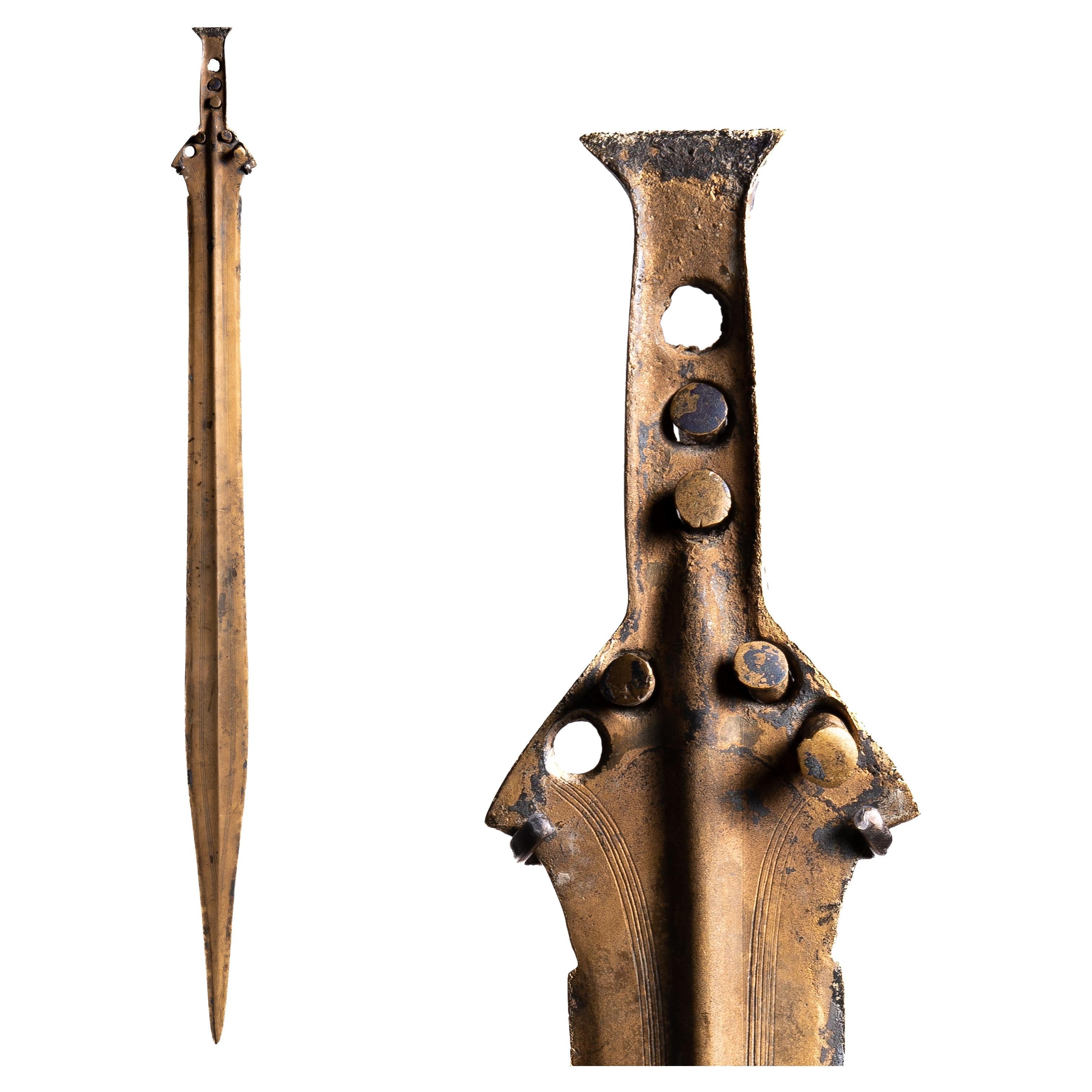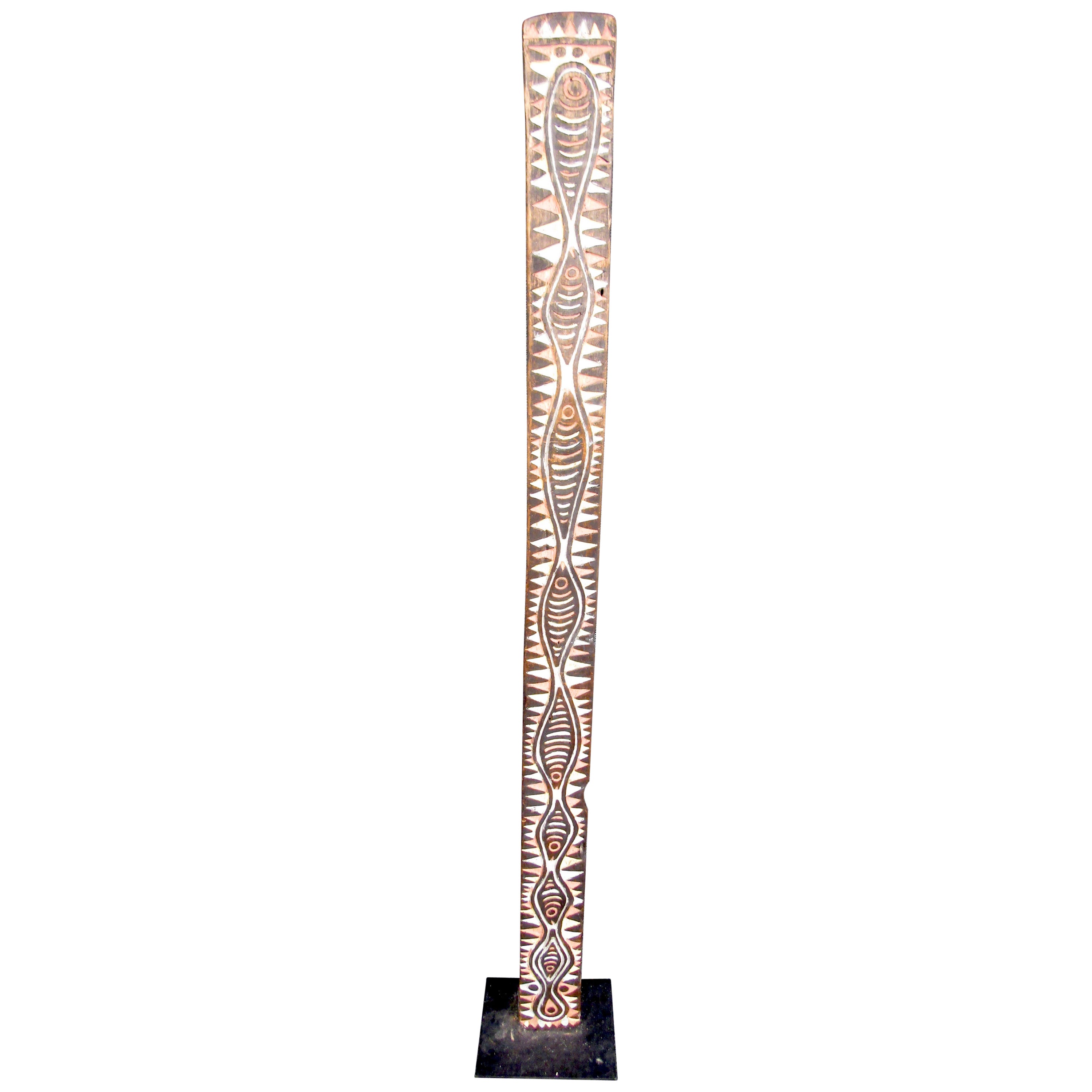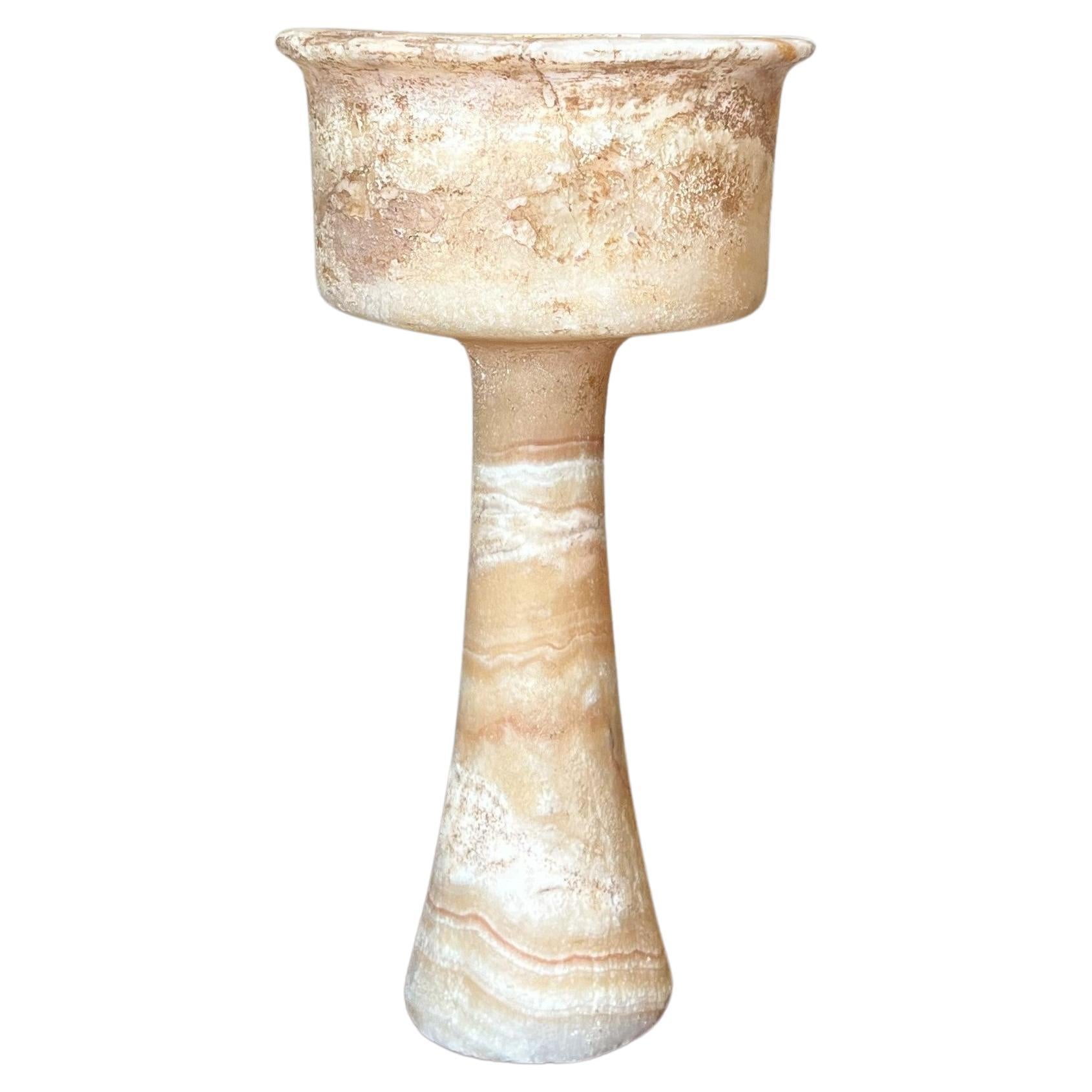Items Similar to Bronze Age Cypriot Plank Idol
Want more images or videos?
Request additional images or videos from the seller
1 of 7
Bronze Age Cypriot Plank Idol
About the Item
Cypriot Plank Idol
Early Bronze Age III - Middle Bronze Age I, c. 2100 - 1850 BC.
Low fired burnished earthenware pottery with lime-filled incisions
A Cypriot plank idol, an iconic form of human representation from Bronze Age Cyprus.
A highly stylised figurine, with a flat rectangular body and narrower head and neck, featuring incised lime-filled decoration across the top half of the body, and two incised lines dropping down from the shoulders. The nose depicted in relief, with incised eyes, eye- brows, nostrils and mouth. Waved line incisions on the edge of the head perhaps indicating hair.
Identified today with the elusive kingdom of Alashiya, Bronze Age Cyprus was an island of unique and distinctive culture. At the beginning of this period (c.2500 BC), migrants from Anatolia introduced the Philia Culture to the northern coast of Cyprus, establishing a new era in the island’s prehistory. Marking the end of the Chalcolithic period, innovative types of pottery were produced, and inhabitants began to experiment with new technologies of bronze metal production.1 In particular, the exploitation of copper resources in the Troodos foothills provided the foundation for acquiring and displaying wealth.2 In high demand throughout the Mediterranean world, Cypriots now exported large quantities of this raw material in exchange for luxury goods such as silver and gold, ivory, perfumed oils, and precious furniture.3 Through such trade, Cyprus established connections with Minoan Crete and Mycenaean Greece, as well as the ancient civilisations of Egypt and the Near East.4 Imported goods from these kingdoms were, in turn, used as status symbols. Over this period, the number and siz- es of settlements also increased, suggesting that this prosperity was underpinned by a rise in population.
The middle Bronze Age also marked an expansion in artistic production, typified by the proliferation of new types of pottery, including Black Slip ware, Red-on-Black ware and white painted ware. Moreover, potters now produced large ‘scenic vessels’ which depicted the everyday activities of the island’s inhabitants, providing invaluable evidence to archaeologists and anthropologists today. The cultural affluence of this period also resulted in huge quantities of grave-goods to accompany a person to the afterlife. The deposition of metal goods in particular reached remarkable heights during this period, and for the first time, tombs included items such as tools and weapons, as well as new types of pottery, and imported jewellery such as gold rings, diadems and faience necklaces. Such evidence has been particularly well documented during the three major excavations at Lapithos. Plank idols are also a common feature of these richly ornamented graves. Tombs themselves were now used for several generations, suggesting that greater emphasis was beginning to be placed on group or family identity. Indeed, this was a time of significant political and economic change, and the emergence of new social structures resulted in lavishly decorated tombs, fulfilling the emerging desire to visually confirm one’s social status, both in life and in death.
Forms of human representation by the artists of ancient Cyprus are easily identifiable to the period they come from. For the early and middle Bronze Age, the traditional form of human representation was the plank idol or figurine. These often simplified forms are highly stylised, with a flat rectangular body, and narrowed head and neck. Facial features and ornaments are indicated by incised and painted patterns, with the exception of the nose and ears (and occasionally breasts) which are modelled in relief. In some cases, they also have two heads, or three necks, or they even depict a mother holding a child. As highly expressive objects, with a significant aesthetic quality, it is clear they were made by skilled potters and designed for visual impact and display. Generally found in graves, their archeological context has led to the belief in their religious and symbolic significance.
When Cypriot plank idols were first discovered in 1913, they were tentatively identified as female. This was the result of their elaborate incised decoration and jewellery, as well as the discovery of some depicted with breasts modelled in relief. Just as large vessels from this period depict scenes from everyday life, it was thought that these figurines may have depicted women in their various roles, for example, as mothers or officiating at the sanctuary in full ceremonial dress. However, the significant absence of male figurines in a presumably patriarchal society led scholars to identify them with the fertility cult of the ‘Great Mother Goddess’. It has been noted that per- haps those idols with two heads or three necks may have been significant in asking for twins, triplets or a larger family. Given that these female figurines are frequently found in graves, it has also been suggested that the fertility goddess was a symbol of rebirth or regeneration.
However, more recently, the identification of plank idols with the Great Mother Goddess has been questioned, on account of the considerable number of figurines that bear no identifying features of the female sex. Instead, their appearance at a time of significant political, hierarchical and economic change, as well as their archaeological contexts has led to the belief that that plank ‘idols’ were in fact figurines designed as a conspicuous symbol of social prestige, and a marker of group identity with particular reference to ancestral authority.
Whether idol or ancestor, these figurines emerge from a crucial time in Cypriot early history, and their aesthetic nature means that they have been highly sought after by the modern collector.
Provenance:
Collection de Mme S.; Objets de Haute Curiosité et d’Archéologie, Hôtel Drouot, Paris, 2nd June 1967, Lot 99.
Mr and Mrs Jacques and Françoise Martinet collection, acquired at the above sale Thence by descent.
- Dimensions:Height: 9 in (22.86 cm)Width: 3 in (7.62 cm)Depth: 0.25 in (6.35 mm)
- Materials and Techniques:
- Place of Origin:
- Period:
- Date of Manufacture:Bronze Age, circa 2100 - 1850 BC
- Condition:Repaired. Wear consistent with age and use.
- Seller Location:London, GB
- Reference Number:1stDibs: LU1052238096252
About the Seller
5.0
Recognized Seller
These prestigious sellers are industry leaders and represent the highest echelon for item quality and design.
Established in 2008
1stDibs seller since 2014
100 sales on 1stDibs
Typical response time: 8 hours
Associations
LAPADA - The Association of Arts & Antiques DealersInternational Confederation of Art and Antique Dealers' AssociationsThe British Antique Dealers' Association
- ShippingRetrieving quote...Ships From: London, United Kingdom
- Return PolicyA return for this item may be initiated within 14 days of delivery.
More From This SellerView All
- Late Bronze Age SwordLocated in London, GBSaint Nazaire Sword, Late Bronze Age, circa 800-900 B.C. An exceptionally well preserved Bronze Age sword, with elegant, finely incised decorations,...Category
Antique 15th Century and Earlier French Abstract Sculptures
MaterialsBronze
- Etruscan Bronze Statuette of Discus ThrowerLocated in London, GBA remarkably fine example of Archaic sculpture. A figure of a discophoros, or discus bearer, standing with his right leg forward, gripping a discus in his right hand, the left arm raised with an open palm. Described with admiration in Münzen und Medaillen's 1961 auction, "The figure is a masterpiece and illustrates with rare vividness the essence of good Etruscan sculpture...Category
Antique 15th Century and Earlier Figurative Sculptures
MaterialsBronze
- Ancient Greek Hellenistic Bronze Statuette of SatyrLocated in London, GBBeautifully cast statuette of a satyr, Greek, Hellenistic Period, 3rd-2nd Century BC, solid cast bronze The present work is a wonderful example of the finest Hellenistic style. The ...Category
Antique 15th Century and Earlier Greek Classical Greek Figurative Sculpt...
MaterialsBronze
- Petrified Incense Cedar Wood FossilLocated in London, GBThis spectacular cross section of petrified cedar wood comes from Saddle Mountain, Washington. It is remarkably large with a wonderful and highly aesthetic shape, exhibiting vibrant ...Category
Antique 15th Century and Earlier Natural Specimens
MaterialsPetrified Wood
- Large Leaf Fossil from the Green River FormationLocated in London, GBA large and beautifully preserved fossilised leaf from the Green River formation, a site which has brought forth some of the best-preserved fossi...Category
Antique 15th Century and Earlier North American Wall-mounted Sculptures
MaterialsOther
- Exceptional Egyptian Sarcophagus MaskLocated in London, GBExceptionally Fine Wooden Sarcophagus Mask Third Intermediate Period, 21st Dynasty, circa 1069-945 BC. Acacia wood, rosewood, hippopotamus ivory Masterfully carved from a single piece of fine-grained hardwood, the present mask is characteristic of the most exquisite funerary art made during the 21st Dynasty, and was probably commissioned for a particularly high-ranking individual. The oval face displays a gently smiling mouth with full, outlined lips, furrows at the corners and a bow-shaped philtrum. The straight nose with rounded nostrils, the cheeks full and fleshy and the large, almond shaped eyes with heavy lids and tapering cosmetic lines, set below long, sweeping eyebrows. Social collapse across the Mediterranean in the Late Bronze Age meant that the 21st Dynasty in Egypt was a period of great turmoil. Trade routes were disrupted, governments collapsed, and mass migration occurred. Economic scarcity meant that traditional funerary practices in Egypt were also affected, with a lack of material and financial resources leading to the reuse of preexisting material. As a result, during the 21st Dynasty, 19th and 20th Dynasty coffins changed ownership rapidly and were heavily recycled for new purposes. Tombs were also unmarked allowing them to be shared by many people. These new practices brought forth a shift in the understanding of funerary paraphernalia. No longer important objects owned forever by the deceased, they were now simply seen as short-term transformative devices, whose symbolic and ritualistic meaning could be appropriated for others. However, paradoxically, the art of coffin-making also reached new heights during this period, and many of the richly dec- orated “yellow” coffins, characteristic of the 21st Dynasty, are remarkable works of art in their own right. Indeed, knowing that coffins were being reused throughout Egypt, the Egyptian élite set themself apart by commissioning lavish sarcophagi decorated with the images and texts meant to help guide them to the afterlife, and which would otherwise have adorned the tomb walls. As coffins were the chief funerary element which now identified the dead and allowed them a physical presence in the world of the living, their quality and appearance were of the utmost importance. The traditional coffin ensemble was made of three parts: a wooden mummy cover, which laid directly atop the mummy, an inner coffin, and an outer coffin, both made of a lid and case. Additional decorative elements, such as masks, were carved out separately and later glued or pegged to the lids. After the completion of the painted decoration, the sarcophagus was covered in a varnish to give it its yellow colour. Gilding was sometimes used for the coffins of the high priests’ families, notably on parts representing naked skin, such as the face mask. However, some of the élite tactically avoided gilding altogether as to ensure that their coffin would not be looted. When manufacturing the inner and outer coffins, particular attention was paid to the woodwork. Displaying the skill of the carpenter, this type of funerary art has largely remained unparalleled throughout Egyptian history. The principal wood used to craft the present mask is Acacia nilotica. The evergreen Egyptian acacia was considered sacred and said to be the tree of life, the birthplace of the god Horus, as well as symbolic of Osiris, the god of the dead and resurrection. The modelling of the face in the wood is superb, but the inlays also help mark this mask out as exceptional. Inlaid eyes and eyebrows were extremely rare and reserved to the finest and most expensive coffins. Traditionally, eyes were made of calcite, obsidian, or quartz, and eyebrows of coloured glass paste or bronze. Here, the pupils, eyebrows, and cosmetic lines are inlaid with Dalbergia melanoxylon, a rare type of wood which belongs to the rosewood genus. In antiquity, however, it was known as Ebony of the Pharaohs, from the Egyptian word “hbny”, meaning dark timber, because of its black, lustrous appearance. An extremely dense and hard wood requiring significant skill to work with, ebony was a luxury material highly coveted by the pharaohs themselves, to make furniture, decorative and funerary objects. The wood was imported with great effort from the southern Land of Punt, most likely modern Sudan, Ethiopia, Djibouti, and Eritrea, alongside other luxury goods such as gold and ivory. A magnificent ebony throne, recovered in the tomb of King Tutankhamun, illustrates the incredible aesthetic potential of this material and why it was so highly valued by Egyptian royalty. Only élite members of Egyptian society could have afford- ed Ebony of the Pharaoh inlays for their funerary mask. The sclerae on the present piece were once both inlaid with hippopotamus ivory. Whiter than elephant ivory, this type of ivory is also denser, and more difficult to carve. The use of this luxury material, reputed for its gleaming appearance, enhances the lifelikeness of the eyes. For the Egyptians, hippopotamus ivory was imbued with magic powers. The hippopotamus was indeed both feared and venerated due to its aggressive behaviour. Whilst the male hippopotamus was associated with danger and chaos, the female was benevolent and invoked for protection, especially of the house and of mothers and their children, through the hippopotamus goddess Tawaret. Thus, not only was hippopotamus ivory used as an inlay and to make practical objects, such as combs and clappers, but it was also used to make talismans like apotropaic wands or knives. Made during a time of scarcity where few could afford made-to-order coffins, the present mask could have only belonged to one of the highest-ranking individuals in society. Undoubtedly one of the finest Egyptian coffin...Category
Antique 15th Century and Earlier Egyptian Egyptian Figurative Sculptures
MaterialsFruitwood, Hardwood
You May Also Like
- Bactrian Marble Column IdolLocated in Vosselaar, BEBactrian marble column idol, circa 3000-2000 Bc. It has a elegant tapering form with a undeep groove running on the top and bottom. The marble is a breccia type with striking vains i...Category
Antique 15th Century and Earlier Afghan Archaistic Antiquities
MaterialsMarble
- Aged Bronze Bucking BroncosLocated in New York, NYPair of mid century Bucking Bronco horse figures with articulating back leg.Category
Mid-20th Century American American Classical Animal Sculptures
MaterialsBronze
- Aged Bronze Bull Bookends, B. SeibelBy Ben SeibelLocated in New York, NYPair of mid century bronze stylized bull bookends by Ben Seibel for Jenfredware.Category
20th Century American Mid-Century Modern Animal Sculptures
MaterialsBronze
- Tribal Plank ArtLocated in Brooklyn, NYUnique tribal plank art with metal base. The piece features a 5.5' tall wooden plank with a colored ornate fish design. Great conversation piece for any space.Category
20th Century Unknown Tribal Tribal Art
MaterialsMetal
- Large Bactrian Bronze Age Alabaster ChaliceLocated in Vosselaar, BEBactrian alabaster chalice, circa 3000-2000 BC. It has an elegant tapering formed base with a undeep rimmed cup. The alabaster is strikingly vained. ...Category
Antique 15th Century and Earlier Afghan Archaistic Antiquities
MaterialsAlabaster
- Archaic Jade Bi, Early Bronze AgeLocated in Atlanta, GATranslucent green and brown jade Bi from the early Bronze age. (2200 - 1900 B.C). The organic shapes created by the blending of these two main colors evo...Category
Antique 15th Century and Earlier Chinese Antiquities
MaterialsJade
Recently Viewed
View AllMore Ways To Browse
Antique Furniture Age
Golded Age
Patterned Bronze
Aged Copper
Middle Ages Furniture
Antique Plank
Aged Terracotta
Large Greek Bronze
Silvered Bronze Greek
Types Of Antique Pottery
Bronze Relief Large
Ancient Greek Bronze
Painted Plank
Huge Bronze
Bronze With Ivory
Antique Bronze Bear
Bronze Pottery
Bronze Male And Female





